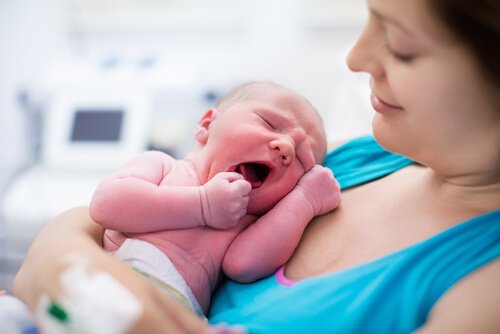How to Care for Episiotomy Stitches After Delivery

Healing episiotomy stitches after delivery at home is one of mothers’ most common concerns. In addition to all the care your baby needs, there are also consequences from delivery that require special care.
After having an episiotomy, nurses will start to take care of the scar at the hospital. However, once the mother goes back home, she needs to take care of it on her own.
Therefore, it’s important to keep certain things in mind so that you prevent complications and infections. We’ll give you some tips and suggestions below to help heal episiotomy stitches after delivery.
What is an episiotomy and when is it necessary?
An episiotomy is a procedure performed during delivery if necessary. The doctor will make an incision between the anus and vulva to increase the vaginal opening.
This procedure makes it easier for the baby to come out. When the child is born, the incision is stitched shut.
Some of the most common causes for this procedure are: the baby is very large and has difficulties getting out; he’s in the wrong position in the birth canal; there’s danger of a bad external vaginal tear.
How long does it take for episiotomy stitches to heal?
If you get this type of incision, postpartum recovery may be a little more painful. However, it will only last a few days.
When it comes to how long it will take for episiotomy stitches to heal, this depends on the length of the incision. Additionally, it depends on how well you take care of it.

In an episiotomy, you need stitches to rejoin the skin and muscle in the area. Generally, they’re made of a material that dissolves or falls off on its own.
In first-degree episiotomies, discomfort usually lasts 2 to 3 weeks. However, in third- or fourth-degree episiotomies, recovery can last up to one month. Generally, these are more common if there’s an interior incision as well.
If you have enough discipline during your recovery, the wound will heal easily and completely. They usually heal well enough that you won’t need your doctor to remove the stitches. Of course, this is when there was no infection throughout the recovery.
How to care for episiotomy stitches after delivery
We already know that after an episiotomy, you’ll have stitches that may cause postpartum discomfort. Luckily, as time goes by, they disintegrate on their own. Since it’s a very sensitive area, you must maintain hygiene in that area and be extremely careful.
Humidity makes the wound take longer to heal. Therefore, it’s important to avoid washing that area too often. Take special care when going to the bathroom.
Make sure to clean and dry all stitches from front to back. Also, make sure that you don’t drag toilet paper across and that you dab instead.
When you wash, use neutral or saline soap and a cotton towel, sterile gauze or paper towels. On the other hand, make sure not to use any scented products because it could irritate the wound.

Other care and precautions
We don’t recommend cotton balls because the threads can get caught in the stitches. Then, they don’t help the episiotomy stitches stay dry because they absorb moisture.
On the other hand, change your postpartum compresses often, and try to use ones that aren’t made of plastic. This way, the wound can stay aerated. In addition, make sure they’re made of a material like cellulose to avoid allergic reactions.
When applying an antiseptic, the best ones have chlorhexidine as an active ingredient. This is the best for breastfeeding mothers. On the contrary, avoid products with iodine. It could pass into the milk and cause some adverse reactions in your baby.
Finally, let the episiotomy stitches breathe a few times throughout the day. This way, you can speed up the healing process.
Another thing to avoid to take care of episiotomy stitches after delivery is standing for a long time. Also, don’t lift heavy objects. Both of these activities make recovery a lot more difficult and take longer.
All cited sources were thoroughly reviewed by our team to ensure their quality, reliability, currency, and validity. The bibliography of this article was considered reliable and of academic or scientific accuracy.
- Corrêa Junior MD, Passini Júnior R. Selective Episiotomy: Indications, Techinique, and Association with Severe Perineal Lacerations. Rev Bras Ginecol Obstet. 2016 Jun;38(6):301-7.
- Laine K, Yli BM, Cole V, Schwarz C et al. European guidelines on perinatal care- Peripartum care Episiotomy. J Matern Fetal Neonatal Med. 2021 Dec 12:1-6.
- Jiang H, Qian X, Carroli G, Garner P. Selective versus routine use of episiotomy for vaginal birth. Cochrane Database Syst Rev. 2017 Feb 8;2(2):CD000081.
- Shmueli A, Gabbay Benziv R, Hiersch L, Ashwal E, Aviram R, Yogev Y, Aviram A. Episiotomy – risk factors and outcomes. J Matern Fetal Neonatal Med. 2017 Feb;30(3):251-256.
- Faraji A, Aghdaki M, Hessami K, Hosseinkhani A, et al. Episiotomy wound healing by Commiphora myrrha (Nees) Engl. and Boswellia carteri Birdw. in primiparous women: A randomized controlled trial. J Ethnopharmacol. 2021 Jan 10;264:113396.
- Abedian S, Abedi P, Jahanfar S, Iravani M, Zahedian M. The effect of Lavender on pain and healing of episiotomy: A systematic review. Complement Ther Med. 2020 Sep;53:102510.
- MedlinePlus. Ejercicios de Kegel. Disponible en: https://medlineplus.gov/spanish/ency/patientinstructions/000141.htm.
- SueloPélvico. Guía Masaje Perineal – Recuperación Episiotomía. Disponible en: https://www.suelopelvico.eu/guia-del-masaje-perineal-recuperacion-episiotomia/.
- Manual MSD. Parto de evolución lenta. Disponible en: https://www.msdmanuals.com/es/hogar/salud-femenina/complicaciones-del-parto/parto-de-evoluci%C3%B3n-lenta.
- MedlinePlus. Infecciones por estafilococo. Disponible en: https://medlineplus.gov/spanish/staphylococcalinfections.html.
This text is provided for informational purposes only and does not replace consultation with a professional. If in doubt, consult your specialist.








